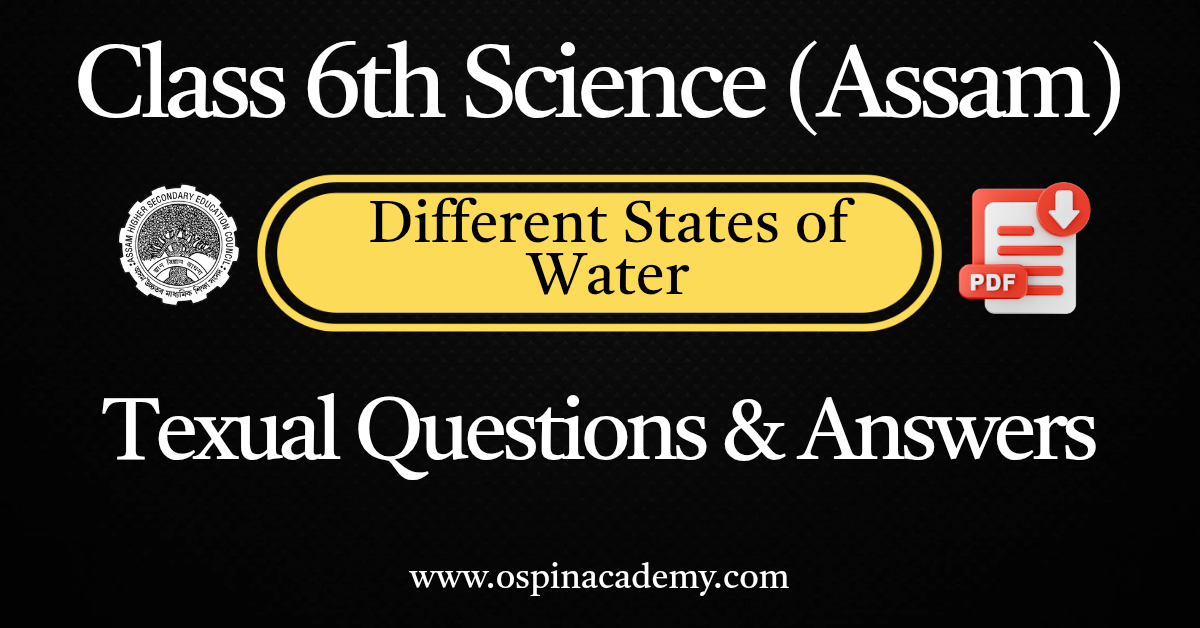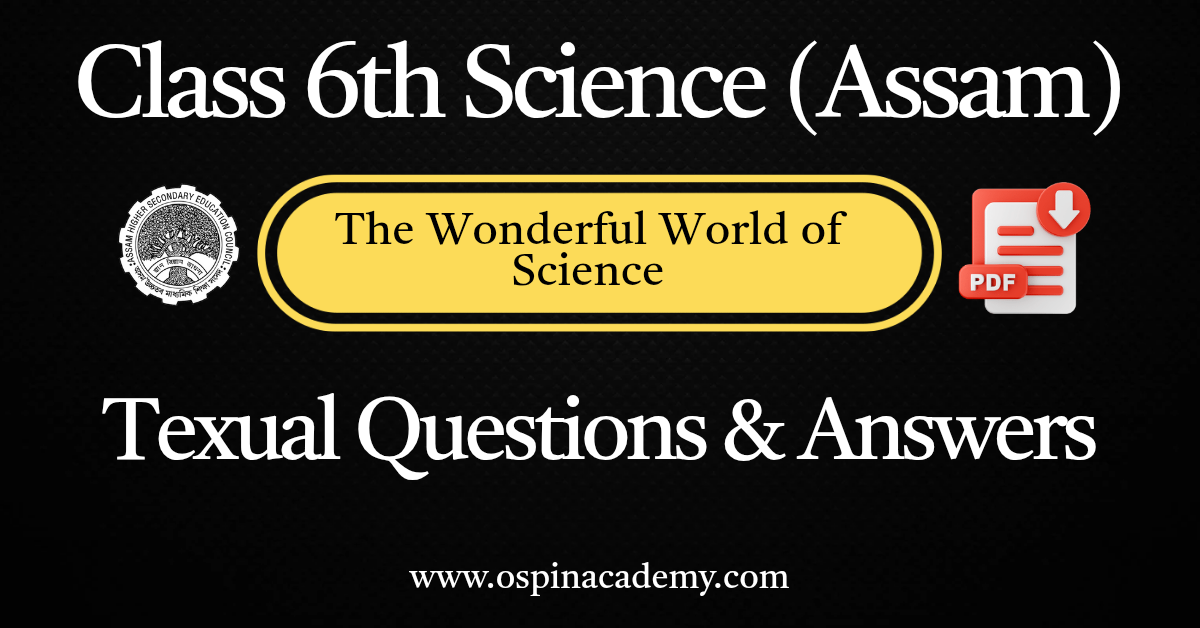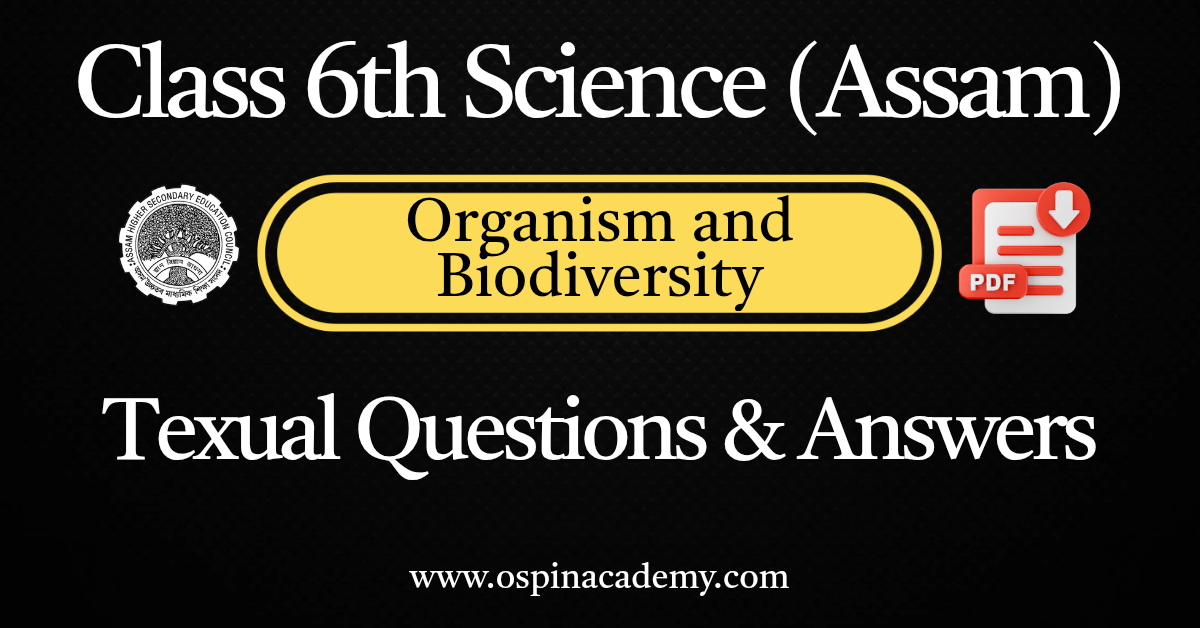Class 6 Science Chapter 11 – Different States of Water Complete Solutions | SCERT Assam (English Medium)
Class 6 Science Chapter 11 – Different States of Water Complete Solutions (SCERT Assam – English Medium)
This chapter explores the different states in which water exists – solid, liquid, and gas – and explains the processes that transform water from one state to another. Following the latest SCERT Assam syllabus for Class 6 Science, all exercise solutions are presented here to aid in student understanding and Board exam preparation. Key points include definitions, real-life examples, and scientific explanations of melting, freezing, condensation, evaporation, and sublimation. Chapter QR Code: F7Z2Z2. Ospin Academy delivers these solutions in clear, student-friendly English for maximum learning benefit.
✅ What you will learn:
- The three states of water: solid, liquid, and gas
- Processes like evaporation, condensation, melting, and freezing
- How water changes its form in nature (water cycle)
- Daily life applications – ice, water, steam, and dew formation
- Scientific experiments and practical uses of states of water
🎯 Benefits of Ospin Academy:
- Complete, chapter-wise solutions as per the latest SCERT Assam curriculum
- Step-by-step explanations for all questions and activities
- Special focus on Board exam questions and answers
- Concepts explained in simple, easy English for all learners
- Real-world examples and practical science applications
Book QR Codes:
- Part 1 Book Code: P4D4R9
- Part 2 Book Code: F5C4J8
SCERT Assam Class 6 Science (Amar Bijnan) – English Medium Chapter-wise Solutions PDF
Special Combo Offer!
(For SCERT Assam Class 6, 2025)
Get complete chapter-wise Science (Amar Bijnan) solutions in English Medium prepared by expert teachers.
Covers all textbook exercises, key concepts, definitions, and diagrams as per the latest SCERT Assam syllabus.
Ideal for concept clarity, homework assistance, and exam preparation.
![]() Class 6th Science
Class 6th Science
Chapter – 11 Ospin Academy
DIFFERENT STATES OF WATER
Exercise
Q.1. Darken the circle of correct answer.
(I) The main reason of cloud formation is
(a) Evaporation
(b) Condensation
(c) Precipitation
(d) Evaporation or condensation
Answer:(d)
(II) What happens due to condensation?
(a) conversion of water into water vapour
(b) conversion of water vapour into water.
(c) cloud formation from droplets of water.
(d) raining from clouds.
Answer:(b)
(III) What happens due to evaporation?
(a) conversion of water vapour into water.
(b) conversion of water into water vapour.
(c) convesion of water into ice.
(d) cloud formation from water droplets.
Answer:(b)
Q.2. Fill up the gap-
(i) The process of drying wet clothes in sunlight is_____.
(ii) The solid state of water is _____ and the gaseous state ofwater is_____.
(iiii) When the atmosphere becomes very cold, the water drop-lets are converted into_______.
(iv) The state of water which does not change its shape is______.
(v) Dew is formed due to ______.
Answer: (i) Evaporation (ii) ice, Water vapour (iii) dew (iv) Solid (v) Condensation
Q.3. To which process the following events are connected (Evaporation or Condensation)(I) If water is splashed on a hot iron bar, water vapour emerges out.
Answer: Evaporation
(II) Drops of water appear on the surface of a glass tumbler containing water with ice cubes.
Answer: Condensation
(III) Water or other food items remain fresh for many days when kept in eigher earthen pot or earthen cooler.
Answer: Evaporation
(IV) The water kept in earthen pitcher remains cooler than the water in metallic pot.
Answer: Evaporation
Q.4. Explain briefty the reasons of the following statments.
(I) During rainy days or in winter season, it is observed that the windshield and the window of a close vehicle become
Answer: This happens due to condensation. During rainy days or winter, the air inside the vehicle is warmer than the cold air outside. When the warm air inside touches the cool windshield or win-dow, the moisture in the air condense into tiny water droplets, making the glass appear smoky
(II) During winter ether the rate of rain is lower or rain does not occur as expected.
Answer: In winter, lower temperatures riduce evaporation, leading to less cloud formation and decreased rainfall.
(III) Water vapour emerges out when iron is used on wet clothes.
Answer: When iron is used on wet clothes, the heat causes the water to evaporate and turn into water vapour.
(IV) When roti is prepared on a pan it puffs up
Answer: When roti is prepared on a hot pan, the water already presentthe dough gets evaporated and the cuater vapours want to go out causing roti to get puffed up.
(V) Wet clothes dry up when kept beneath the fan.
Answer: Wet clothes dry up when kept beneath the fan because the moving air increases the rate of evaporation by carrying away moisture from the cloth.
Q.5. Explain
(i) Water droplets appear on the surface of a water bottle if it is brought out from a refrigerator.
Answer: This occurs due to condensation. When the cold bottle is taken out of the refrigerator, water vapour from the air comes in con-tact with the cold surface of the water bottle and gets converted to water droplets.
(ii) Water cycle does not occur without evaporation and con-densation.
Answer: The water cycle is a continuous process in which water movesthrough different phases in nature. Water from occans, lakes evaporates due to heat. The water vapour then condenses into clouds and eventually, the condensed water falls back as rain. So without evaporation and condensation, the water cycle would not be possible.
Q.6. Why do we sec dew on the leaves of plants during winter?
Answer: During winter, when the atmosphere becomes cool, the water vapour in the air condenses and forms small drops of water on the leaves. These drops of water are called dew.
Q.7. Why does surface water dry up under the sunlight.
Answer: Surface water dries up under sunlight because the heat from the sun causes the water to evaporate. The heat energy turns the liquid water into water vapour, which mines with the air and rises into the atmosphere
Q.8. Write the name of a substance which we can get in three states as in water. Answer: Oxygen is a substance that can exist in three states -(i) Solid oxygen (at very low temperature)):
(ii) Liquied oxygen used in medical and industrial fields
(iii) Gaseous oxygen (what we breathe in)
Q.9. What are the factors that affect evaporation?
Answer: Factors that affect evaporation are
(i) Temperature
(iii) Humidity
(ii) Surface area
(iv) Wind speed
Q.10. Why do our hands feel cold when-we apply hand sanitizer?
Answer: When we apply hand sanitizen, it quickly evaporates from our skin. During evaporation, it takes away heat from our hands, making them feel cold.
Class 6 Science Chapter 11 – Frequently Asked Questions
Get Free NCERT PDFs
If you want to download free PDFs of any chapter, click the link below and join our WhatsApp group:




